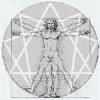B833 <=> B835 (BTG XL Heptaparaparshinokh, p. 834)
“This famous experimental apparatus Alla-attapan consisted of three independent parts.
“The fore part was called ‘Loosochepana,’ the middle part ‘Dzendvokh,’ and the last, the hind part, was called ‘Riank-Pokhotarz.’
“Each of these three parts in their turn consisted of several special and separate adaptations.
“The first part which was named Loosochepana had a special cone-shaped pipe, the wide end of which was hermetically fitted into a frame of the sole window of that room where the experiments were made, and the other end was a small chinklike aperture with what is called a ‘collecting-disk,’ passing through which what are called the rays of ‘daylight’ coming from the window were transformed into as your favorites would say, a ‘concentrated-white-ray.’
“This concentrated-white-ray thereupon passing through a crystal of a special form was broken up into seven different ‘colored rays’ which, as is said, fell upon a small slab made of ivory and called ‘Pirinjiel.’
“This slab Pirinjiel was so constructed and regulated that the colored rays falling on it were again concentrated, but this time otherwise, and, proceeding through the second crystal, also of a special form, fell on another but larger slab, also made of ivory and called ‘Polorishboorda.’
“Opposite this Polorishboorda was a small apparatus of a special construction through which, on its being shifted in a certain way, any chosen colored ray there could be directed further from this Polorishboorda on to the third part of the Alla-attapan called ‘Riank-Pokhotarz.’
“Here, by the way, you might as well also be told that the knowledge relating to the construction of the first crystal of this part of the apparatus Alla-attapan also reached down to your contemporary favorites and they now call this crystal a ‘prism.’

